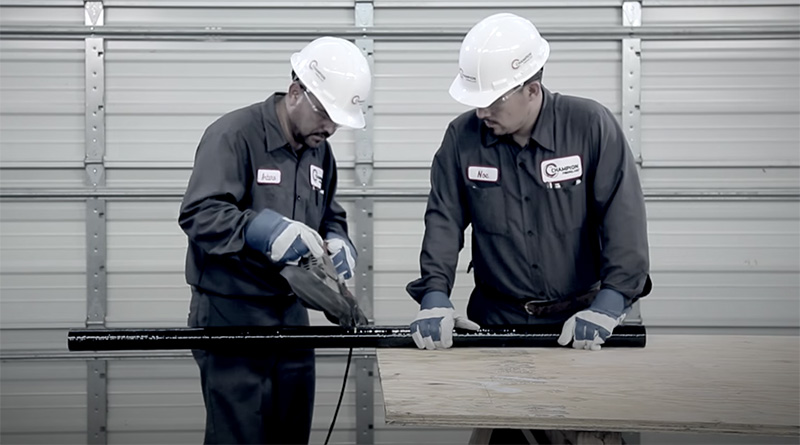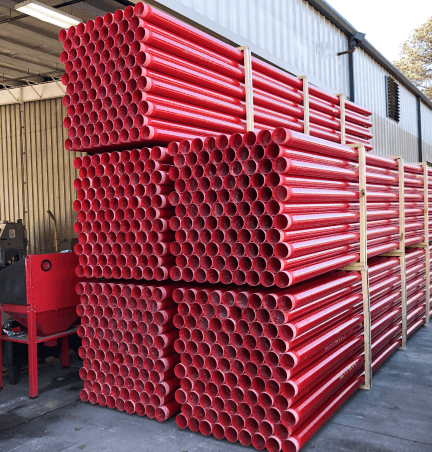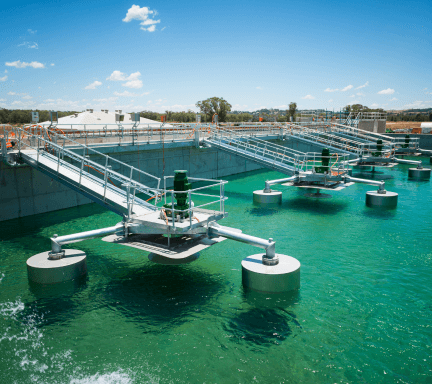Fiberglass conduit is known for its seamless installation. In fact, contractors frequently comment on the ease at which fiberglass RTRC conduit is installed. Fast installation is achieved thanks to the product’s light weight, portability and ease of cutting in the field.
With the right tools, fiberglass (RTRC) conduit field cuts are smooth and simple.
But before getting into the details it is important to note that the following guidelines must be verified by the contractor or installer and approved by the engineer of record. It is imperative to read and understand all information and instructional manuals for the safe use of any equipment or tool mentioned in this article. Failure to understand and allow the safe operation of any equipment or tool could result in an accident causing serious injury or death.



Fiberglass Cutting Tool Recommendations
Suggested field cutting tools include a hand-held hacksaw with a fine-tooth blade, a portable bandsaw, a chop saw with a diamond cutting blade and an abrasive blade cutter. These tools are recommended due to their ability to make clean cuts to fiberglass. Here’s more detail about each tool to help you decide which one makes sense for your job:
- A chop saw with a diamond cutting blade.
- An abrasive blade cutter is very portable and much faster than using a hand-held hacksaw.
- A porta-band saw is common to job sites where metal conduit is being cut.
- A hand-held hacksaw with a fine-tooth blade is very portable and commonly available in the field.
A SawzallⓇ is not recommended for cutting fiberglass conduit as the high speed reciprocation can damage the conduit.
Preparation & Protection
Gather all tools and proper field cutting personal protection equipment (PPE) to protect skin, hands, eyes and lungs: long sleeved clothing, gloves, safety glasses and a particulate respirator mask (N95).
How to Cut RTRC Conduit in the Field
- Ensure proper safety equipment is used.
- Measure the conduit to your desired length and mark the fiberglass conduit cut lines with a contrasting colored marker. Be sure to measure and mark your cutting points at a minimum of three inches to each end of the conduit for installing coupling or termination fittings.
- Cut at cut lines using one of the following commonly-used field cutting tools:
- A chop saw with a diamond cutting blade
- An abrasive blade cutter
- A porta-band saw
- A hand-held hacksaw with a fine-tooth blade
- After cutting at your pre-measured marks, remove loose fibers from the cut surfaces.
- Remove any cutting burrs or ridges by sanding and deburring (additional sanding is only necessary when the pre-sanded factory end of the conduit has been removed).
- Using the fiberglass fitting, verify the outside diameter of the conduit.
- Remove any cutting burrs or ridges with a 60-grit emery cloth before bonding.
For additional installation information refer to Champion Fiberglass’s full library of Fiberglass Conduit Video Installation Guides.
Keep Reading
Champion Fiberglass® Named a CompositesWorld Top Shop for 2024
The origins of fiberglass date back to the ancient Greeks. Today fiberglass is used for a variety of applications from…
Get to Know Research and Development Engineer Blake Rogers
He’s got a diverse background in engineering, is new to Texas and can juggle. Meet Blake Rogers.
Electrical Conduit Cost Savings: A Must-Have Guide for Engineers & Contractors
To help identify cost savings that don’t cut corners on quality, Champion Fiberglass developed a free resource for engineers and…










